Maternal Healthcare in Relation to Primary Health Care Principles
VerifiedAdded on 2020/04/01
|9
|2402
|695
Essay
AI Summary
This essay examines the crucial role of nurses in maternal healthcare, emphasizing its alignment with five key primary health care principles: intersectoral collaboration, community participation, manpower development, accessibility and equity, and the use of appropriate technology. The essay defines healthcare and the various roles of nurses, including research, education, care and treatment, health promotion, and family health. It differentiates between primary, secondary, and tertiary healthcare levels, focusing on how maternal healthcare, as a primary health service, should be accessible to all mothers and children, regardless of financial constraints. The essay highlights the importance of skilled health personnel, community involvement, collaboration with other sectors, and the use of appropriate technology to ensure cost-effective and quality maternal healthcare services, advocating for equitable and comprehensive healthcare delivery.
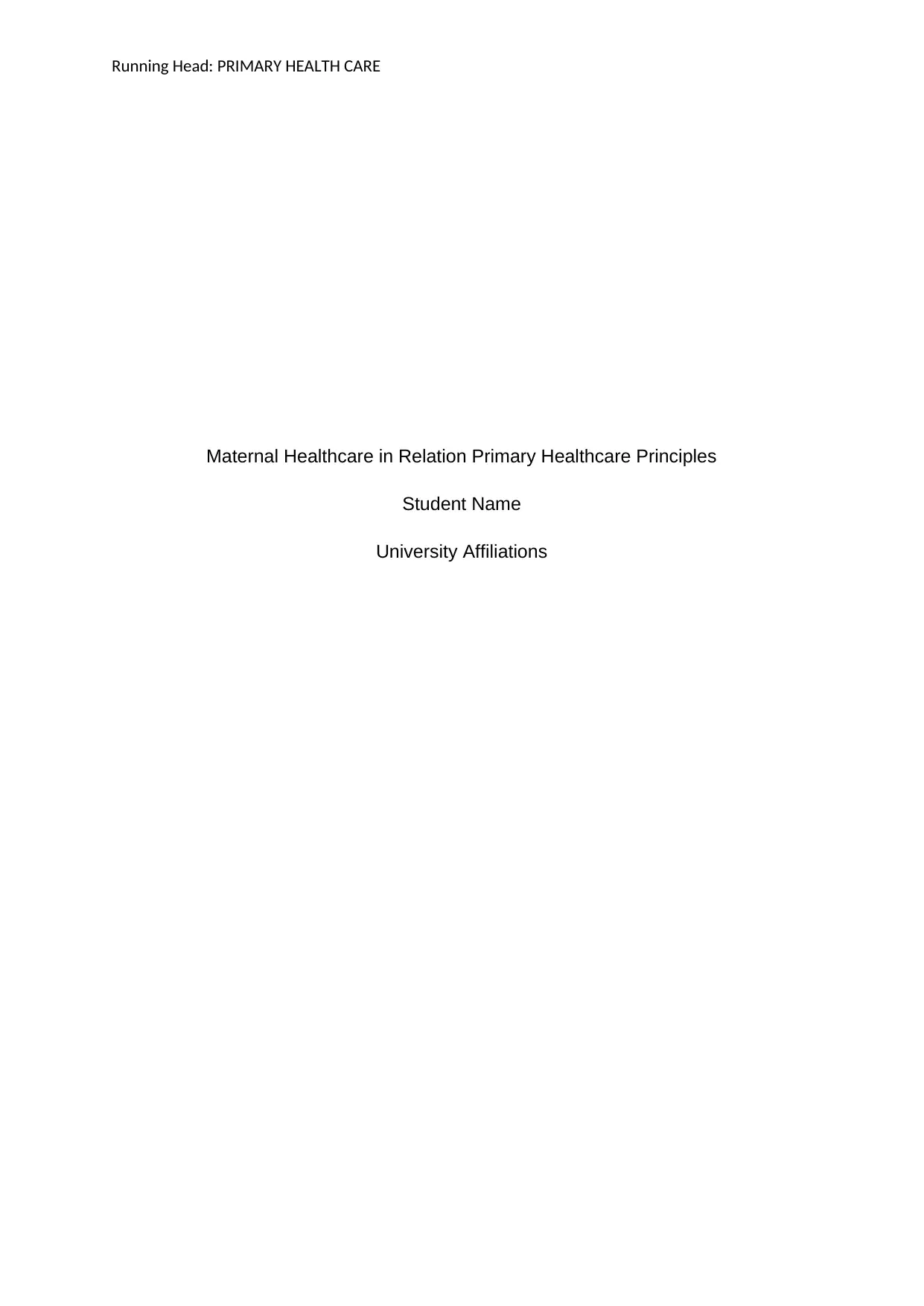
Running Head: PRIMARY HEALTH CARE
Maternal Healthcare in Relation Primary Healthcare Principles
Student Name
University Affiliations
Maternal Healthcare in Relation Primary Healthcare Principles
Student Name
University Affiliations
Paraphrase This Document
Need a fresh take? Get an instant paraphrase of this document with our AI Paraphraser
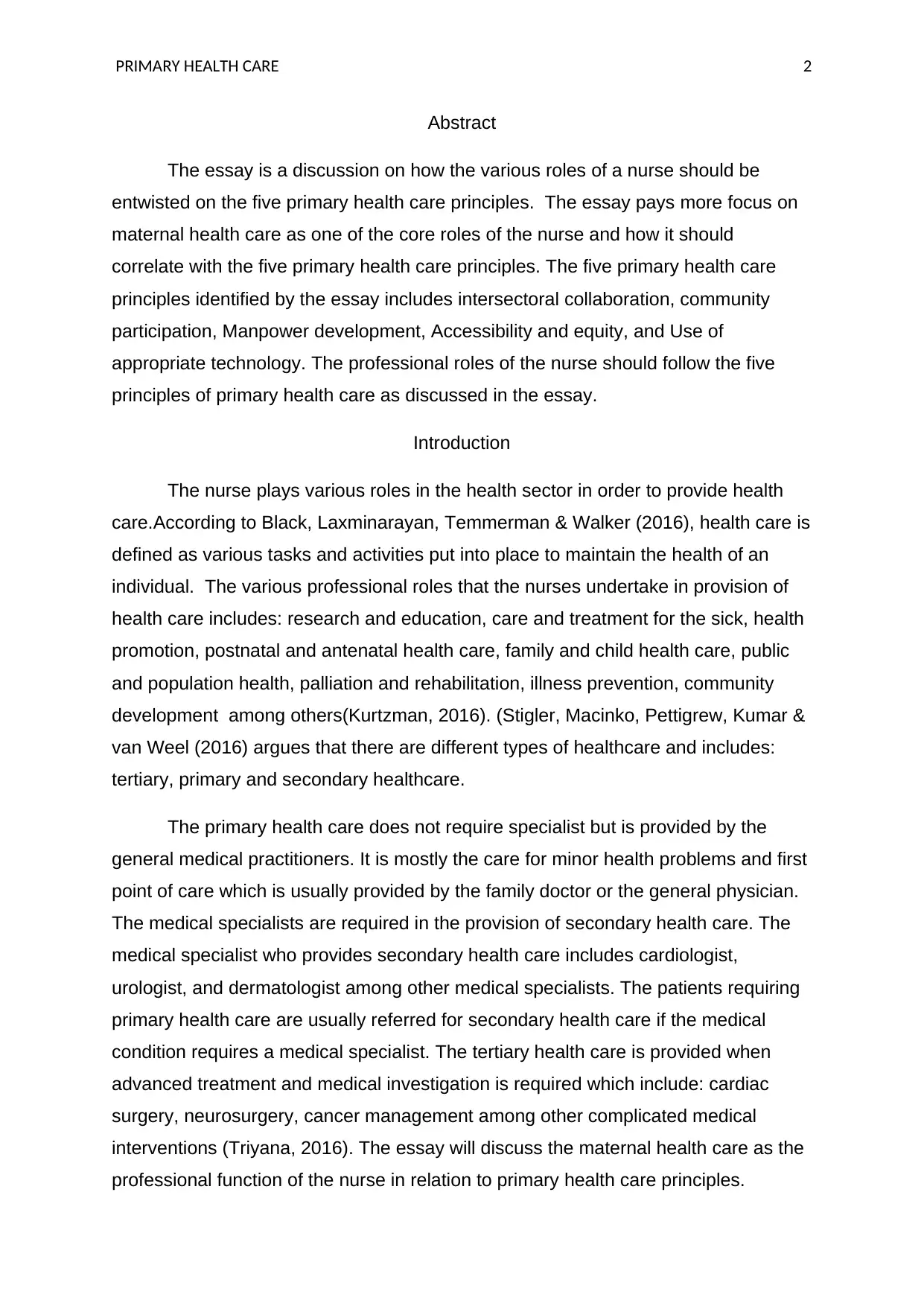
PRIMARY HEALTH CARE 2
Abstract
The essay is a discussion on how the various roles of a nurse should be
entwisted on the five primary health care principles. The essay pays more focus on
maternal health care as one of the core roles of the nurse and how it should
correlate with the five primary health care principles. The five primary health care
principles identified by the essay includes intersectoral collaboration, community
participation, Manpower development, Accessibility and equity, and Use of
appropriate technology. The professional roles of the nurse should follow the five
principles of primary health care as discussed in the essay.
Introduction
The nurse plays various roles in the health sector in order to provide health
care.According to Black, Laxminarayan, Temmerman & Walker (2016), health care is
defined as various tasks and activities put into place to maintain the health of an
individual. The various professional roles that the nurses undertake in provision of
health care includes: research and education, care and treatment for the sick, health
promotion, postnatal and antenatal health care, family and child health care, public
and population health, palliation and rehabilitation, illness prevention, community
development among others(Kurtzman, 2016). (Stigler, Macinko, Pettigrew, Kumar &
van Weel (2016) argues that there are different types of healthcare and includes:
tertiary, primary and secondary healthcare.
The primary health care does not require specialist but is provided by the
general medical practitioners. It is mostly the care for minor health problems and first
point of care which is usually provided by the family doctor or the general physician.
The medical specialists are required in the provision of secondary health care. The
medical specialist who provides secondary health care includes cardiologist,
urologist, and dermatologist among other medical specialists. The patients requiring
primary health care are usually referred for secondary health care if the medical
condition requires a medical specialist. The tertiary health care is provided when
advanced treatment and medical investigation is required which include: cardiac
surgery, neurosurgery, cancer management among other complicated medical
interventions (Triyana, 2016). The essay will discuss the maternal health care as the
professional function of the nurse in relation to primary health care principles.
Abstract
The essay is a discussion on how the various roles of a nurse should be
entwisted on the five primary health care principles. The essay pays more focus on
maternal health care as one of the core roles of the nurse and how it should
correlate with the five primary health care principles. The five primary health care
principles identified by the essay includes intersectoral collaboration, community
participation, Manpower development, Accessibility and equity, and Use of
appropriate technology. The professional roles of the nurse should follow the five
principles of primary health care as discussed in the essay.
Introduction
The nurse plays various roles in the health sector in order to provide health
care.According to Black, Laxminarayan, Temmerman & Walker (2016), health care is
defined as various tasks and activities put into place to maintain the health of an
individual. The various professional roles that the nurses undertake in provision of
health care includes: research and education, care and treatment for the sick, health
promotion, postnatal and antenatal health care, family and child health care, public
and population health, palliation and rehabilitation, illness prevention, community
development among others(Kurtzman, 2016). (Stigler, Macinko, Pettigrew, Kumar &
van Weel (2016) argues that there are different types of healthcare and includes:
tertiary, primary and secondary healthcare.
The primary health care does not require specialist but is provided by the
general medical practitioners. It is mostly the care for minor health problems and first
point of care which is usually provided by the family doctor or the general physician.
The medical specialists are required in the provision of secondary health care. The
medical specialist who provides secondary health care includes cardiologist,
urologist, and dermatologist among other medical specialists. The patients requiring
primary health care are usually referred for secondary health care if the medical
condition requires a medical specialist. The tertiary health care is provided when
advanced treatment and medical investigation is required which include: cardiac
surgery, neurosurgery, cancer management among other complicated medical
interventions (Triyana, 2016). The essay will discuss the maternal health care as the
professional function of the nurse in relation to primary health care principles.
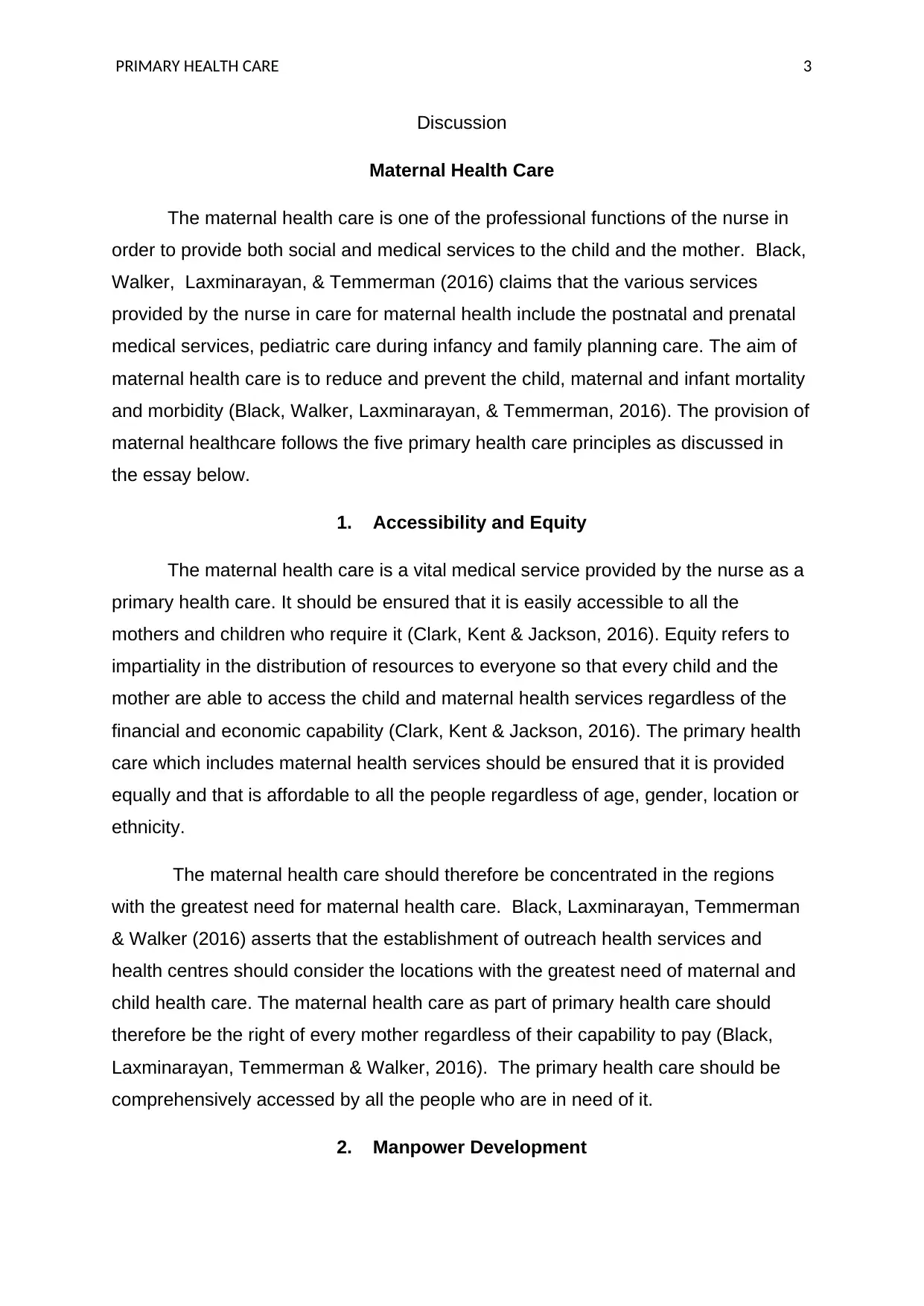
PRIMARY HEALTH CARE 3
Discussion
Maternal Health Care
The maternal health care is one of the professional functions of the nurse in
order to provide both social and medical services to the child and the mother. Black,
Walker, Laxminarayan, & Temmerman (2016) claims that the various services
provided by the nurse in care for maternal health include the postnatal and prenatal
medical services, pediatric care during infancy and family planning care. The aim of
maternal health care is to reduce and prevent the child, maternal and infant mortality
and morbidity (Black, Walker, Laxminarayan, & Temmerman, 2016). The provision of
maternal healthcare follows the five primary health care principles as discussed in
the essay below.
1. Accessibility and Equity
The maternal health care is a vital medical service provided by the nurse as a
primary health care. It should be ensured that it is easily accessible to all the
mothers and children who require it (Clark, Kent & Jackson, 2016). Equity refers to
impartiality in the distribution of resources to everyone so that every child and the
mother are able to access the child and maternal health services regardless of the
financial and economic capability (Clark, Kent & Jackson, 2016). The primary health
care which includes maternal health services should be ensured that it is provided
equally and that is affordable to all the people regardless of age, gender, location or
ethnicity.
The maternal health care should therefore be concentrated in the regions
with the greatest need for maternal health care. Black, Laxminarayan, Temmerman
& Walker (2016) asserts that the establishment of outreach health services and
health centres should consider the locations with the greatest need of maternal and
child health care. The maternal health care as part of primary health care should
therefore be the right of every mother regardless of their capability to pay (Black,
Laxminarayan, Temmerman & Walker, 2016). The primary health care should be
comprehensively accessed by all the people who are in need of it.
2. Manpower Development
Discussion
Maternal Health Care
The maternal health care is one of the professional functions of the nurse in
order to provide both social and medical services to the child and the mother. Black,
Walker, Laxminarayan, & Temmerman (2016) claims that the various services
provided by the nurse in care for maternal health include the postnatal and prenatal
medical services, pediatric care during infancy and family planning care. The aim of
maternal health care is to reduce and prevent the child, maternal and infant mortality
and morbidity (Black, Walker, Laxminarayan, & Temmerman, 2016). The provision of
maternal healthcare follows the five primary health care principles as discussed in
the essay below.
1. Accessibility and Equity
The maternal health care is a vital medical service provided by the nurse as a
primary health care. It should be ensured that it is easily accessible to all the
mothers and children who require it (Clark, Kent & Jackson, 2016). Equity refers to
impartiality in the distribution of resources to everyone so that every child and the
mother are able to access the child and maternal health services regardless of the
financial and economic capability (Clark, Kent & Jackson, 2016). The primary health
care which includes maternal health services should be ensured that it is provided
equally and that is affordable to all the people regardless of age, gender, location or
ethnicity.
The maternal health care should therefore be concentrated in the regions
with the greatest need for maternal health care. Black, Laxminarayan, Temmerman
& Walker (2016) asserts that the establishment of outreach health services and
health centres should consider the locations with the greatest need of maternal and
child health care. The maternal health care as part of primary health care should
therefore be the right of every mother regardless of their capability to pay (Black,
Laxminarayan, Temmerman & Walker, 2016). The primary health care should be
comprehensively accessed by all the people who are in need of it.
2. Manpower Development
⊘ This is a preview!⊘
Do you want full access?
Subscribe today to unlock all pages.

Trusted by 1+ million students worldwide
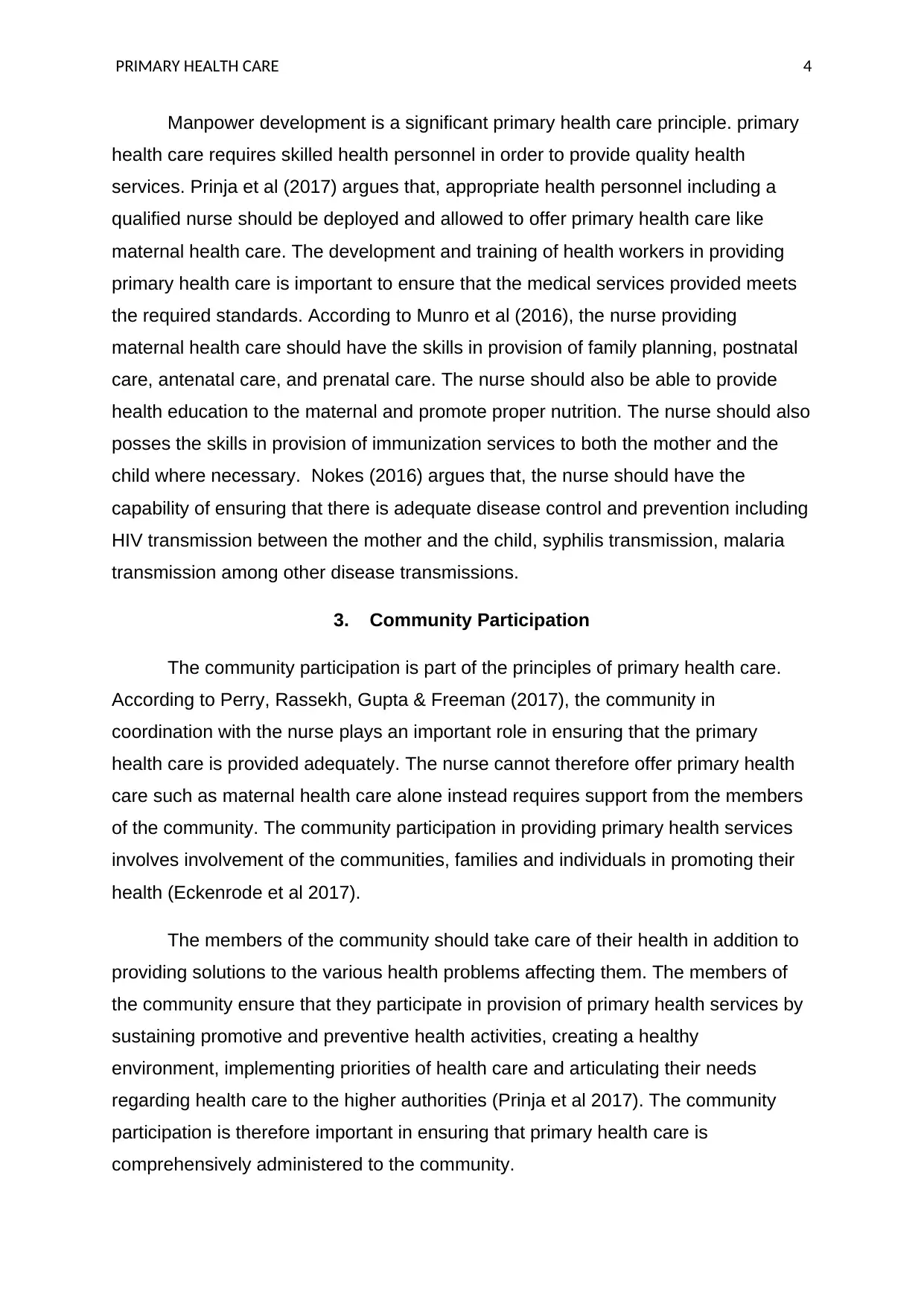
PRIMARY HEALTH CARE 4
Manpower development is a significant primary health care principle. primary
health care requires skilled health personnel in order to provide quality health
services. Prinja et al (2017) argues that, appropriate health personnel including a
qualified nurse should be deployed and allowed to offer primary health care like
maternal health care. The development and training of health workers in providing
primary health care is important to ensure that the medical services provided meets
the required standards. According to Munro et al (2016), the nurse providing
maternal health care should have the skills in provision of family planning, postnatal
care, antenatal care, and prenatal care. The nurse should also be able to provide
health education to the maternal and promote proper nutrition. The nurse should also
posses the skills in provision of immunization services to both the mother and the
child where necessary. Nokes (2016) argues that, the nurse should have the
capability of ensuring that there is adequate disease control and prevention including
HIV transmission between the mother and the child, syphilis transmission, malaria
transmission among other disease transmissions.
3. Community Participation
The community participation is part of the principles of primary health care.
According to Perry, Rassekh, Gupta & Freeman (2017), the community in
coordination with the nurse plays an important role in ensuring that the primary
health care is provided adequately. The nurse cannot therefore offer primary health
care such as maternal health care alone instead requires support from the members
of the community. The community participation in providing primary health services
involves involvement of the communities, families and individuals in promoting their
health (Eckenrode et al 2017).
The members of the community should take care of their health in addition to
providing solutions to the various health problems affecting them. The members of
the community ensure that they participate in provision of primary health services by
sustaining promotive and preventive health activities, creating a healthy
environment, implementing priorities of health care and articulating their needs
regarding health care to the higher authorities (Prinja et al 2017). The community
participation is therefore important in ensuring that primary health care is
comprehensively administered to the community.
Manpower development is a significant primary health care principle. primary
health care requires skilled health personnel in order to provide quality health
services. Prinja et al (2017) argues that, appropriate health personnel including a
qualified nurse should be deployed and allowed to offer primary health care like
maternal health care. The development and training of health workers in providing
primary health care is important to ensure that the medical services provided meets
the required standards. According to Munro et al (2016), the nurse providing
maternal health care should have the skills in provision of family planning, postnatal
care, antenatal care, and prenatal care. The nurse should also be able to provide
health education to the maternal and promote proper nutrition. The nurse should also
posses the skills in provision of immunization services to both the mother and the
child where necessary. Nokes (2016) argues that, the nurse should have the
capability of ensuring that there is adequate disease control and prevention including
HIV transmission between the mother and the child, syphilis transmission, malaria
transmission among other disease transmissions.
3. Community Participation
The community participation is part of the principles of primary health care.
According to Perry, Rassekh, Gupta & Freeman (2017), the community in
coordination with the nurse plays an important role in ensuring that the primary
health care is provided adequately. The nurse cannot therefore offer primary health
care such as maternal health care alone instead requires support from the members
of the community. The community participation in providing primary health services
involves involvement of the communities, families and individuals in promoting their
health (Eckenrode et al 2017).
The members of the community should take care of their health in addition to
providing solutions to the various health problems affecting them. The members of
the community ensure that they participate in provision of primary health services by
sustaining promotive and preventive health activities, creating a healthy
environment, implementing priorities of health care and articulating their needs
regarding health care to the higher authorities (Prinja et al 2017). The community
participation is therefore important in ensuring that primary health care is
comprehensively administered to the community.
Paraphrase This Document
Need a fresh take? Get an instant paraphrase of this document with our AI Paraphraser
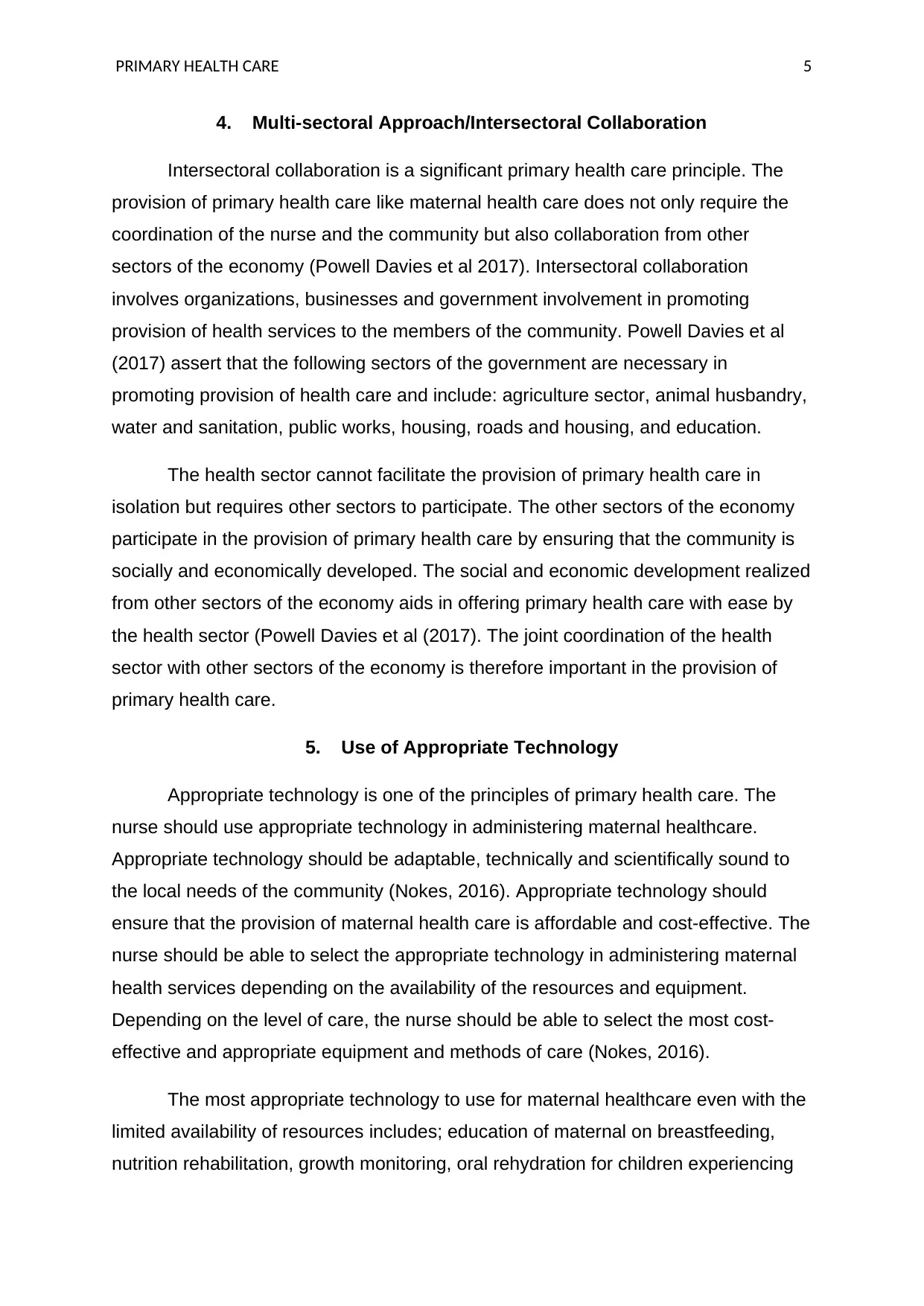
PRIMARY HEALTH CARE 5
4. Multi-sectoral Approach/Intersectoral Collaboration
Intersectoral collaboration is a significant primary health care principle. The
provision of primary health care like maternal health care does not only require the
coordination of the nurse and the community but also collaboration from other
sectors of the economy (Powell Davies et al 2017). Intersectoral collaboration
involves organizations, businesses and government involvement in promoting
provision of health services to the members of the community. Powell Davies et al
(2017) assert that the following sectors of the government are necessary in
promoting provision of health care and include: agriculture sector, animal husbandry,
water and sanitation, public works, housing, roads and housing, and education.
The health sector cannot facilitate the provision of primary health care in
isolation but requires other sectors to participate. The other sectors of the economy
participate in the provision of primary health care by ensuring that the community is
socially and economically developed. The social and economic development realized
from other sectors of the economy aids in offering primary health care with ease by
the health sector (Powell Davies et al (2017). The joint coordination of the health
sector with other sectors of the economy is therefore important in the provision of
primary health care.
5. Use of Appropriate Technology
Appropriate technology is one of the principles of primary health care. The
nurse should use appropriate technology in administering maternal healthcare.
Appropriate technology should be adaptable, technically and scientifically sound to
the local needs of the community (Nokes, 2016). Appropriate technology should
ensure that the provision of maternal health care is affordable and cost-effective. The
nurse should be able to select the appropriate technology in administering maternal
health services depending on the availability of the resources and equipment.
Depending on the level of care, the nurse should be able to select the most cost-
effective and appropriate equipment and methods of care (Nokes, 2016).
The most appropriate technology to use for maternal healthcare even with the
limited availability of resources includes; education of maternal on breastfeeding,
nutrition rehabilitation, growth monitoring, oral rehydration for children experiencing
4. Multi-sectoral Approach/Intersectoral Collaboration
Intersectoral collaboration is a significant primary health care principle. The
provision of primary health care like maternal health care does not only require the
coordination of the nurse and the community but also collaboration from other
sectors of the economy (Powell Davies et al 2017). Intersectoral collaboration
involves organizations, businesses and government involvement in promoting
provision of health services to the members of the community. Powell Davies et al
(2017) assert that the following sectors of the government are necessary in
promoting provision of health care and include: agriculture sector, animal husbandry,
water and sanitation, public works, housing, roads and housing, and education.
The health sector cannot facilitate the provision of primary health care in
isolation but requires other sectors to participate. The other sectors of the economy
participate in the provision of primary health care by ensuring that the community is
socially and economically developed. The social and economic development realized
from other sectors of the economy aids in offering primary health care with ease by
the health sector (Powell Davies et al (2017). The joint coordination of the health
sector with other sectors of the economy is therefore important in the provision of
primary health care.
5. Use of Appropriate Technology
Appropriate technology is one of the principles of primary health care. The
nurse should use appropriate technology in administering maternal healthcare.
Appropriate technology should be adaptable, technically and scientifically sound to
the local needs of the community (Nokes, 2016). Appropriate technology should
ensure that the provision of maternal health care is affordable and cost-effective. The
nurse should be able to select the appropriate technology in administering maternal
health services depending on the availability of the resources and equipment.
Depending on the level of care, the nurse should be able to select the most cost-
effective and appropriate equipment and methods of care (Nokes, 2016).
The most appropriate technology to use for maternal healthcare even with the
limited availability of resources includes; education of maternal on breastfeeding,
nutrition rehabilitation, growth monitoring, oral rehydration for children experiencing
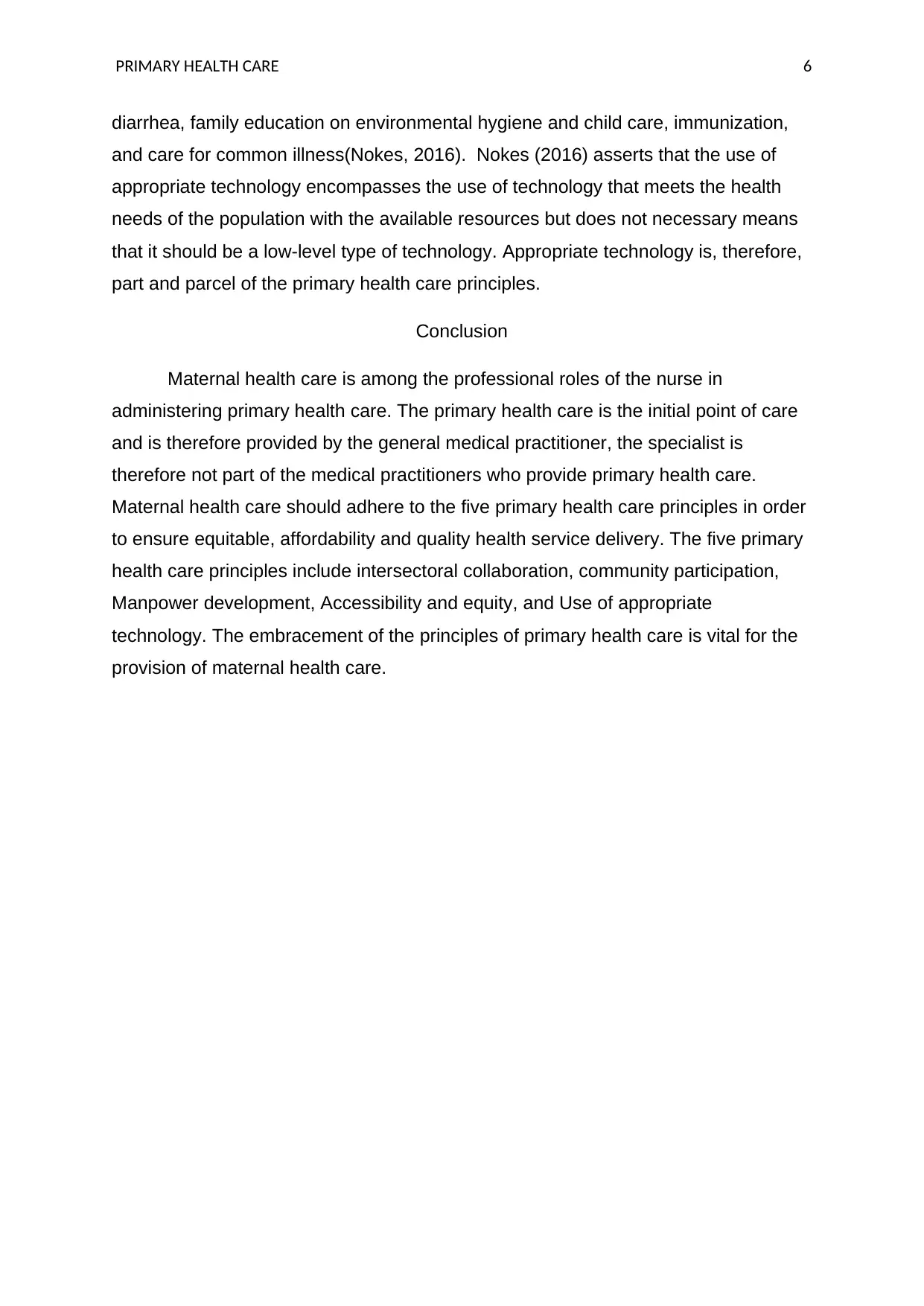
PRIMARY HEALTH CARE 6
diarrhea, family education on environmental hygiene and child care, immunization,
and care for common illness(Nokes, 2016). Nokes (2016) asserts that the use of
appropriate technology encompasses the use of technology that meets the health
needs of the population with the available resources but does not necessary means
that it should be a low-level type of technology. Appropriate technology is, therefore,
part and parcel of the primary health care principles.
Conclusion
Maternal health care is among the professional roles of the nurse in
administering primary health care. The primary health care is the initial point of care
and is therefore provided by the general medical practitioner, the specialist is
therefore not part of the medical practitioners who provide primary health care.
Maternal health care should adhere to the five primary health care principles in order
to ensure equitable, affordability and quality health service delivery. The five primary
health care principles include intersectoral collaboration, community participation,
Manpower development, Accessibility and equity, and Use of appropriate
technology. The embracement of the principles of primary health care is vital for the
provision of maternal health care.
diarrhea, family education on environmental hygiene and child care, immunization,
and care for common illness(Nokes, 2016). Nokes (2016) asserts that the use of
appropriate technology encompasses the use of technology that meets the health
needs of the population with the available resources but does not necessary means
that it should be a low-level type of technology. Appropriate technology is, therefore,
part and parcel of the primary health care principles.
Conclusion
Maternal health care is among the professional roles of the nurse in
administering primary health care. The primary health care is the initial point of care
and is therefore provided by the general medical practitioner, the specialist is
therefore not part of the medical practitioners who provide primary health care.
Maternal health care should adhere to the five primary health care principles in order
to ensure equitable, affordability and quality health service delivery. The five primary
health care principles include intersectoral collaboration, community participation,
Manpower development, Accessibility and equity, and Use of appropriate
technology. The embracement of the principles of primary health care is vital for the
provision of maternal health care.
⊘ This is a preview!⊘
Do you want full access?
Subscribe today to unlock all pages.

Trusted by 1+ million students worldwide
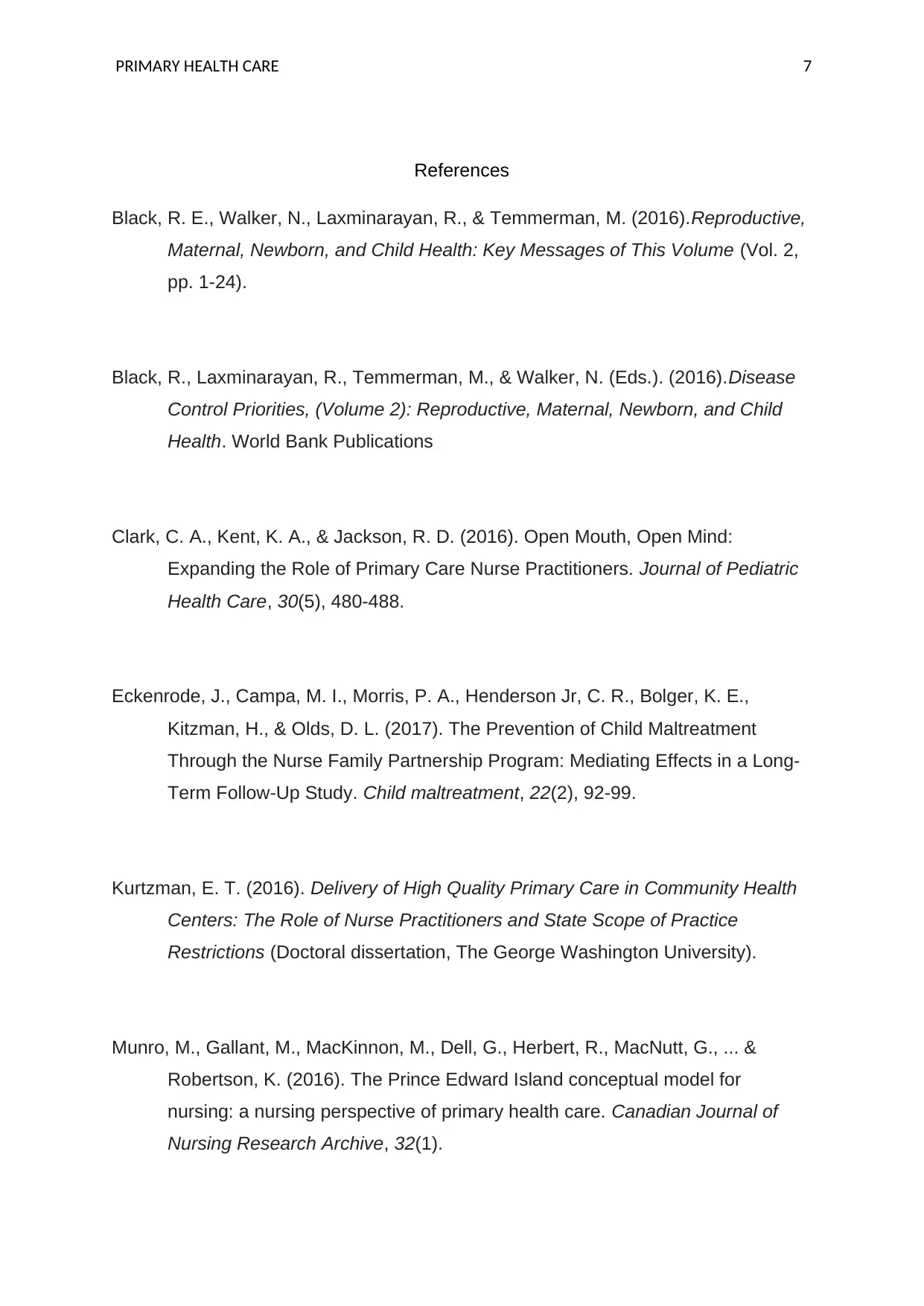
PRIMARY HEALTH CARE 7
References
Black, R. E., Walker, N., Laxminarayan, R., & Temmerman, M. (2016).Reproductive,
Maternal, Newborn, and Child Health: Key Messages of This Volume (Vol. 2,
pp. 1-24).
Black, R., Laxminarayan, R., Temmerman, M., & Walker, N. (Eds.). (2016).Disease
Control Priorities, (Volume 2): Reproductive, Maternal, Newborn, and Child
Health. World Bank Publications
Clark, C. A., Kent, K. A., & Jackson, R. D. (2016). Open Mouth, Open Mind:
Expanding the Role of Primary Care Nurse Practitioners. Journal of Pediatric
Health Care, 30(5), 480-488.
Eckenrode, J., Campa, M. I., Morris, P. A., Henderson Jr, C. R., Bolger, K. E.,
Kitzman, H., & Olds, D. L. (2017). The Prevention of Child Maltreatment
Through the Nurse Family Partnership Program: Mediating Effects in a Long-
Term Follow-Up Study. Child maltreatment, 22(2), 92-99.
Kurtzman, E. T. (2016). Delivery of High Quality Primary Care in Community Health
Centers: The Role of Nurse Practitioners and State Scope of Practice
Restrictions (Doctoral dissertation, The George Washington University).
Munro, M., Gallant, M., MacKinnon, M., Dell, G., Herbert, R., MacNutt, G., ... &
Robertson, K. (2016). The Prince Edward Island conceptual model for
nursing: a nursing perspective of primary health care. Canadian Journal of
Nursing Research Archive, 32(1).
References
Black, R. E., Walker, N., Laxminarayan, R., & Temmerman, M. (2016).Reproductive,
Maternal, Newborn, and Child Health: Key Messages of This Volume (Vol. 2,
pp. 1-24).
Black, R., Laxminarayan, R., Temmerman, M., & Walker, N. (Eds.). (2016).Disease
Control Priorities, (Volume 2): Reproductive, Maternal, Newborn, and Child
Health. World Bank Publications
Clark, C. A., Kent, K. A., & Jackson, R. D. (2016). Open Mouth, Open Mind:
Expanding the Role of Primary Care Nurse Practitioners. Journal of Pediatric
Health Care, 30(5), 480-488.
Eckenrode, J., Campa, M. I., Morris, P. A., Henderson Jr, C. R., Bolger, K. E.,
Kitzman, H., & Olds, D. L. (2017). The Prevention of Child Maltreatment
Through the Nurse Family Partnership Program: Mediating Effects in a Long-
Term Follow-Up Study. Child maltreatment, 22(2), 92-99.
Kurtzman, E. T. (2016). Delivery of High Quality Primary Care in Community Health
Centers: The Role of Nurse Practitioners and State Scope of Practice
Restrictions (Doctoral dissertation, The George Washington University).
Munro, M., Gallant, M., MacKinnon, M., Dell, G., Herbert, R., MacNutt, G., ... &
Robertson, K. (2016). The Prince Edward Island conceptual model for
nursing: a nursing perspective of primary health care. Canadian Journal of
Nursing Research Archive, 32(1).
Paraphrase This Document
Need a fresh take? Get an instant paraphrase of this document with our AI Paraphraser
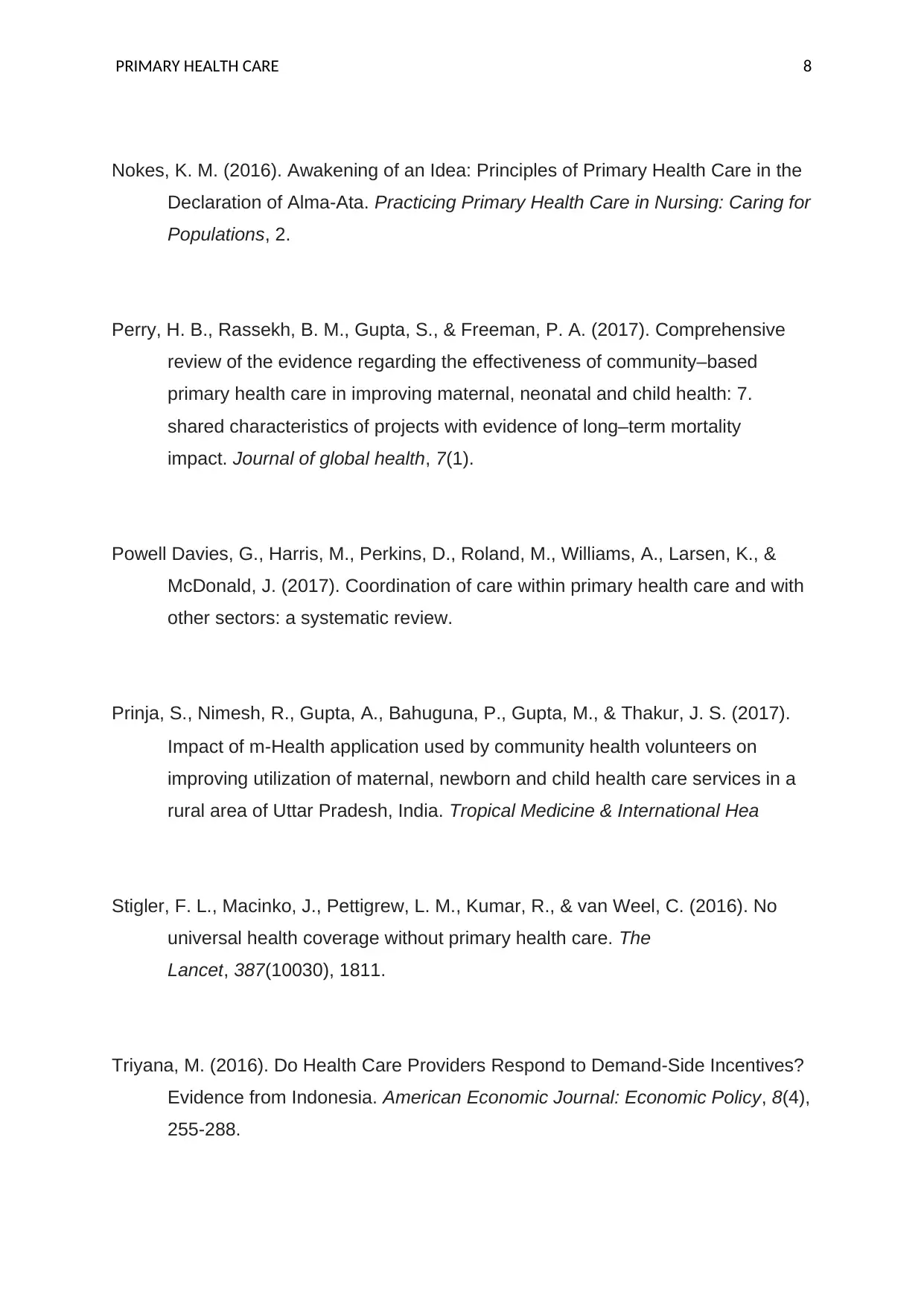
PRIMARY HEALTH CARE 8
Nokes, K. M. (2016). Awakening of an Idea: Principles of Primary Health Care in the
Declaration of Alma-Ata. Practicing Primary Health Care in Nursing: Caring for
Populations, 2.
Perry, H. B., Rassekh, B. M., Gupta, S., & Freeman, P. A. (2017). Comprehensive
review of the evidence regarding the effectiveness of community–based
primary health care in improving maternal, neonatal and child health: 7.
shared characteristics of projects with evidence of long–term mortality
impact. Journal of global health, 7(1).
Powell Davies, G., Harris, M., Perkins, D., Roland, M., Williams, A., Larsen, K., &
McDonald, J. (2017). Coordination of care within primary health care and with
other sectors: a systematic review.
Prinja, S., Nimesh, R., Gupta, A., Bahuguna, P., Gupta, M., & Thakur, J. S. (2017).
Impact of m‐Health application used by community health volunteers on
improving utilization of maternal, newborn and child health care services in a
rural area of Uttar Pradesh, India. Tropical Medicine & International Hea
Stigler, F. L., Macinko, J., Pettigrew, L. M., Kumar, R., & van Weel, C. (2016). No
universal health coverage without primary health care. The
Lancet, 387(10030), 1811.
Triyana, M. (2016). Do Health Care Providers Respond to Demand-Side Incentives?
Evidence from Indonesia. American Economic Journal: Economic Policy, 8(4),
255-288.
Nokes, K. M. (2016). Awakening of an Idea: Principles of Primary Health Care in the
Declaration of Alma-Ata. Practicing Primary Health Care in Nursing: Caring for
Populations, 2.
Perry, H. B., Rassekh, B. M., Gupta, S., & Freeman, P. A. (2017). Comprehensive
review of the evidence regarding the effectiveness of community–based
primary health care in improving maternal, neonatal and child health: 7.
shared characteristics of projects with evidence of long–term mortality
impact. Journal of global health, 7(1).
Powell Davies, G., Harris, M., Perkins, D., Roland, M., Williams, A., Larsen, K., &
McDonald, J. (2017). Coordination of care within primary health care and with
other sectors: a systematic review.
Prinja, S., Nimesh, R., Gupta, A., Bahuguna, P., Gupta, M., & Thakur, J. S. (2017).
Impact of m‐Health application used by community health volunteers on
improving utilization of maternal, newborn and child health care services in a
rural area of Uttar Pradesh, India. Tropical Medicine & International Hea
Stigler, F. L., Macinko, J., Pettigrew, L. M., Kumar, R., & van Weel, C. (2016). No
universal health coverage without primary health care. The
Lancet, 387(10030), 1811.
Triyana, M. (2016). Do Health Care Providers Respond to Demand-Side Incentives?
Evidence from Indonesia. American Economic Journal: Economic Policy, 8(4),
255-288.

PRIMARY HEALTH CARE 9
⊘ This is a preview!⊘
Do you want full access?
Subscribe today to unlock all pages.

Trusted by 1+ million students worldwide
1 out of 9
Related Documents
Your All-in-One AI-Powered Toolkit for Academic Success.
+13062052269
info@desklib.com
Available 24*7 on WhatsApp / Email
![[object Object]](/_next/static/media/star-bottom.7253800d.svg)
Unlock your academic potential
Copyright © 2020–2025 A2Z Services. All Rights Reserved. Developed and managed by ZUCOL.





